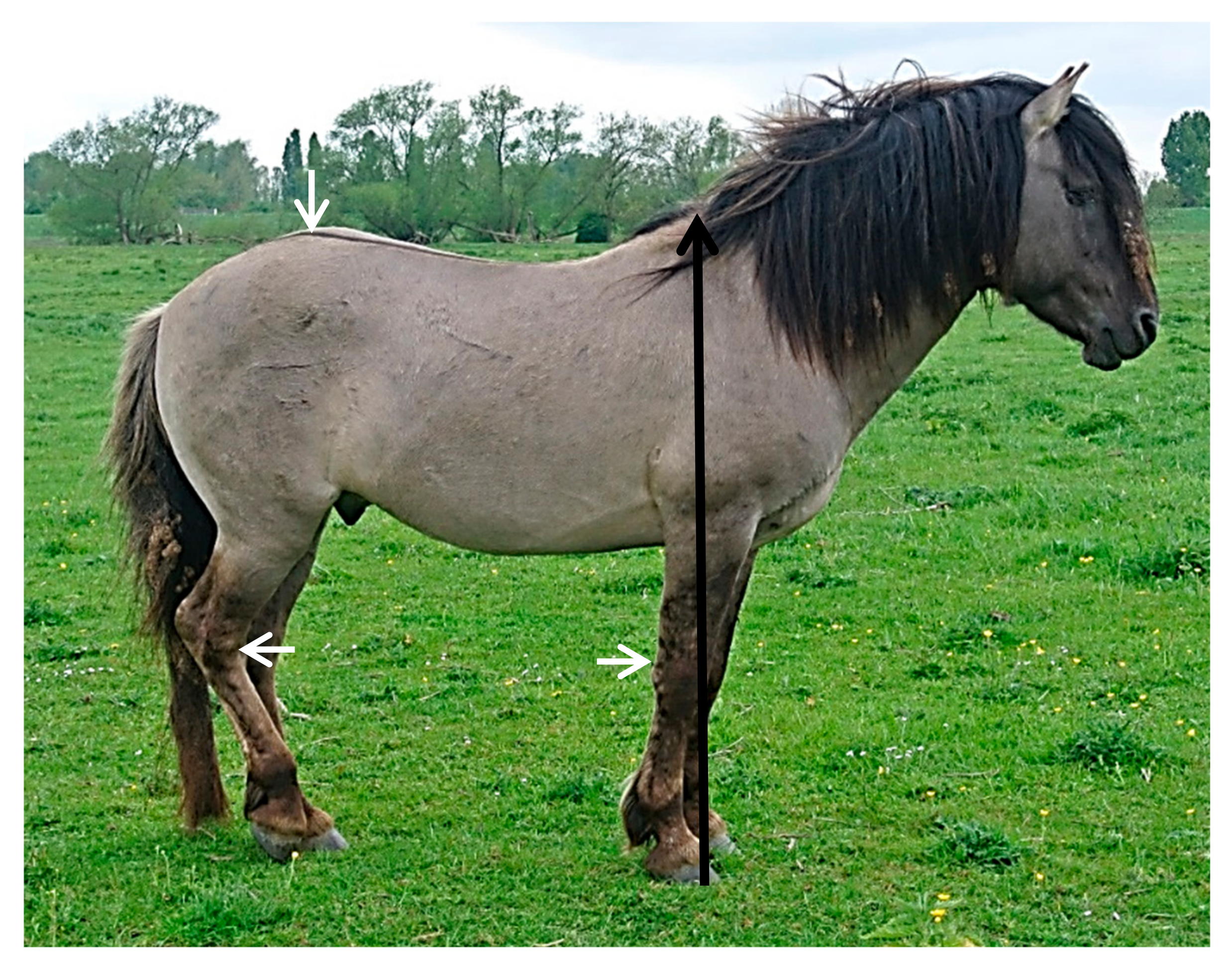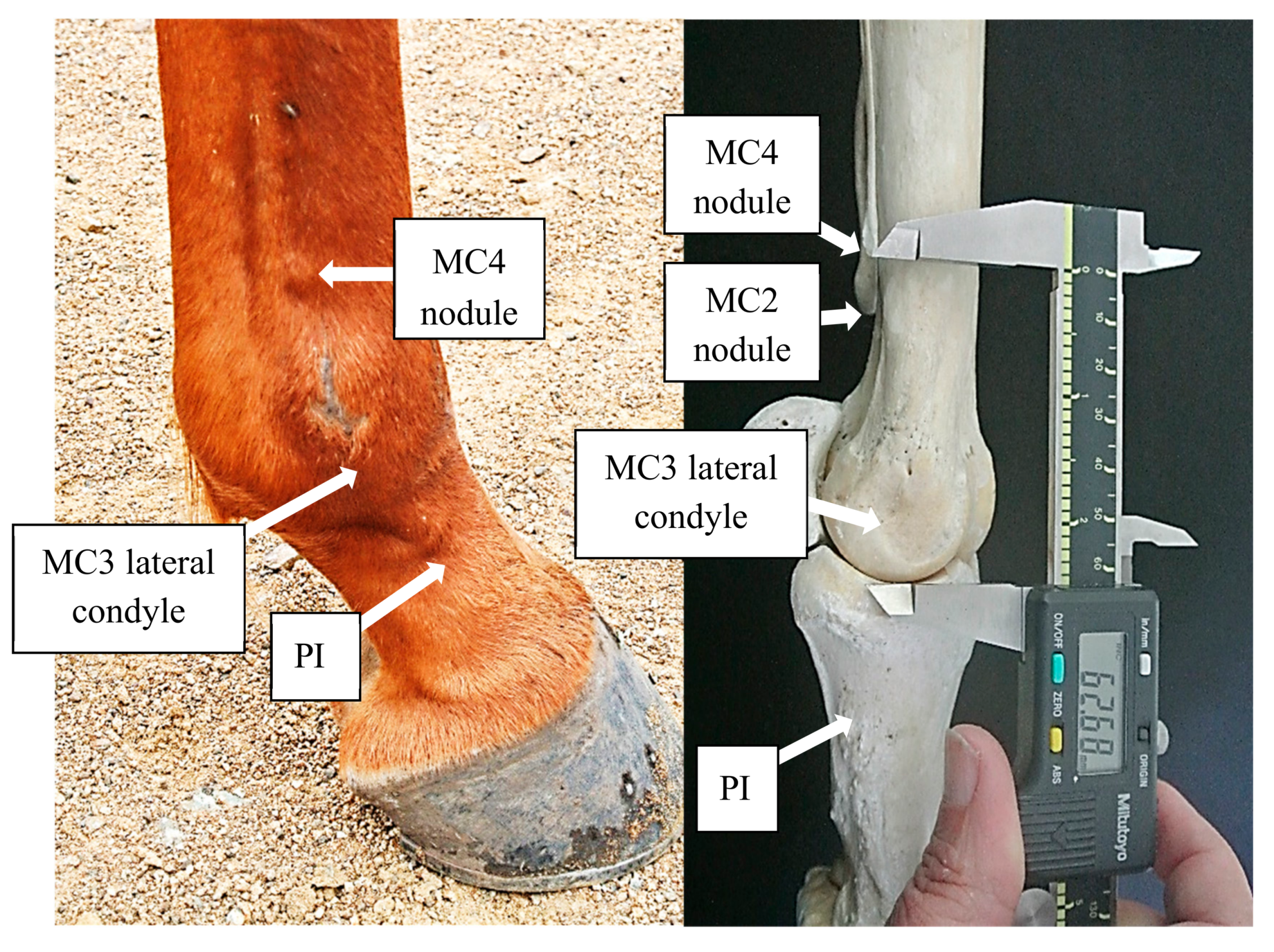A Novel Non-Invasive Selection Criterion for the Preservation of Primitive Dutch Konik Horses
Abstract
1. Introduction
2. Materials and Methods
2.1. Ethical Statement
2.2. Animal Details
2.3. Dissections and Measurements
2.4. Statistical Analysis
3. Results
3.1. Dutch Konik Horse—Forelegs
3.2. Dutch Konik Horse—Hindlegs
3.3. Domesticate Horse—Forelegs
3.4. Domesticate Horse—Hindlegs
3.5. Dutch Konik versus Domesticate
4. Discussion
5. Conclusions
Acknowledgments
Author Contributions
Conflicts of Interest
References
- Sponenberg, D.P. Chapter 14: Genetic resources and their conservation. In The Genetics of the Horse; Bowling, A.T., Ruvinsky, A., Eds.; CABI Publishing: Oxon, UK, 2000; pp. 388–409. [Google Scholar]
- Pasicka, E. Polish Konik Horse—Characteristics and historical background of native descendants of Tarpan. Acta Sci. Pol. Med. Vet. 2013, 12, 25–38. [Google Scholar]
- Janikowski, T. The wild horse of Poland. Nature 1942, 150, 681–682. [Google Scholar] [CrossRef][Green Version]
- Jansen, T.; Forster, P.; Levine, M.A.; Oelke, H.; Hurles, M.; Renfrew, C.; Weber, J.; Olek, K. Mitochondrial DNA and the origins of domestic horse. Proc. Natl. Acad. Sci. USA 2002, 99, 10905–10910. [Google Scholar] [CrossRef] [PubMed]
- Van Vuure, T. On the origin of the Polish konik and its relation to Dutch nature management. Lutra 2014, 57, 111–130. [Google Scholar]
- Stefaniuk-Szmukier, K.; Ropka-Molik, K.; Piorkowska, K.; Szmatola, T.; Dlugosz, B.; Pisarczyk, W.; Bugno-Poniewierska, M. Variation in TBX3 gene region in dun colour Polish Konik horses. J. Equine Vet. Sci. 2017, 49, 60–62. [Google Scholar] [CrossRef]
- Wolc, A.; Balinska, K. Inbreeding effects on exterior traits in Polish Konik horses. Arch. Tierz. 2010, 53, 1–8. [Google Scholar] [CrossRef][Green Version]
- Grygoruk, M.; noj-Bazille, U.B.; Mzgajski, M.; Sienkiewicz, J. Chapter 14: Climate-Induced Challenges for Wetlands: Revealing the Background for the Adaptive Ecosystem Management in the Biebrza Valley, Poland. In Managing Protected Areas in Central and Eastern Europe Under Climate Change; Rannow, S., Neubert, M., Eds.; Springer Open: London, UK, 2009; pp. 209–232. [Google Scholar]
- Vera, F.; Buissank, F. Wilderness in Europe: What Really Goes on between the Trees and the Beasts; Tirion Publishers: Baarn, The Netherlands, 2007; pp. 38–115, 138–199. [Google Scholar]
- Hillen, R.; Hillen, J.D.; Vera, F. The Oostvaardersplassen: Beyond the Horizon of the Familiar; Dutch Forestry Commission: Driebergen, The Netherlands, 2010; pp. 33–48. [Google Scholar]
- Vera, F. (Retired Biologist, Wijk bij Duurstede, The Netherlands). Personal communication, 16 September 2016.
- Vrolijk, J. (Director Free Nature, Beuningen, The Netherlands); de Bode, T. (Manager Free Nature, Beuningen, The Netherlands). Director and Manager respectively for Free Nature: Foundation for restoring European Ecosystems. Personal communication, 15 September 2017. [Google Scholar]
- ICMO2. Natural Processes, Animal Welfare, Moral Aspects and Management of the Oostvaardersplassen; Report of the second International Commission on Management of the Oostvaardersplassen (ICMO2); Wing Rapport 039; ICMO2: The Hague, The Netherlands; Wageningen, The Netherlands, 2010. [Google Scholar]
- Marris, E. Reflecting the past. Nature 2009, 462, 30–32. [Google Scholar] [CrossRef] [PubMed][Green Version]
- Anonymous. Stud-book of Origin of Konik Polski Breed. Polish Horse Breeders Association. Warsaw, Poland. 1992. Available online: http://pzhk.pl/en/breeding/polish-breeds/stud-book-of-origin-of-konik-polski-breed (accessed on 31 May 2017).
- Stachurska, A.; Brodacki, A. The issue of blue dun shade inheritance in the horse. Electron. J. Pol. Agric. Univ. 2003. Available online: https://www.researchgate.net/publication/267969479 (accessed on 25 January 2016).
- Stachurska, A.M. Inheritance of primitive markings in horses. J. Anim. Breed. Genet. 1999, 116, 29–38. [Google Scholar] [CrossRef]
- Stachurska, A.; Ussing, A.P. White markings in horses. Medycyna Weterynaryjna 2012, 68, 74–78. [Google Scholar]
- Pasicka, E.; Tarnawski, K.; ChrÓszcz, A.; Geringer de Oedenberg, H. Morphometric changes in Polish Konik mares after nearly a Hundred years of the breed’s existence. Anat. Hist. Embryol. 2017, 46, 249–257. [Google Scholar] [CrossRef] [PubMed]
- Komosa, M.; Purzyc, H. Konik and Hucal horses: A comparative study of exterior measurements. J. Anim. Sci. 2009, 87, 2245–2254. [Google Scholar] [CrossRef] [PubMed]
- Getty, R. Chapter 15: Equine Osteology. In The Anatomy of the Domestic Animals, 5th ed.; Sisson, S., Grossman, J.D., Eds.; W.B. Saunders: Philadelphia, PA, USA, 1975; pp. 289–291. [Google Scholar]
- Robb, R.C. A Study of mutations in evolution: The evolution of the equine foot. J. Genet. 1935, 31, 39–52. [Google Scholar] [CrossRef]
- McHorse, B.K.; Biewener, A.A.; Pierce, S.E. Mechanics of evolutionary digit reduction in fossil horses (Equidae). Proc. Biol. Sci. 2017, 284, 1–8. [Google Scholar] [CrossRef] [PubMed]
- Piotrowski, G.; Sullivan, M.; Colahan, P.T. Geometric properties of equine metacarpi. J. Biomech. 1983, 16, 129–139. [Google Scholar] [CrossRef]



| Descriptor | Measurement Description |
|---|---|
| mMC2 | On the caudomedial aspect, place the fixed caliper arm at the distal point of the nodule on MC2; then extend the movable caliper arm to the distal edge of the medial MC3 condyle. |
| mMC4 | On the caudolateral aspect, place the fixed caliper arm at the distal point of the nodule on MC4; then extend the movable caliper arm to the distal edge of the lateral MC3 condyle. |
| mMT2 | On the caudomedial aspect, place the fixed caliper arm at the distal point of the nodule on MT2; then extend the movable caliper arm to the distal edge of the medial MT3 condyle. |
| mMT4 | On the caudolateral aspect, place the fixed caliper arm at the distal point of the nodule on MT4; then extend the movable caliper arm to the distal edge of the lateral MT3 condyle. |
© 2018 by the authors. Licensee MDPI, Basel, Switzerland. This article is an open access article distributed under the terms and conditions of the Creative Commons Attribution (CC BY) license (http://creativecommons.org/licenses/by/4.0/).
Share and Cite
May-Davis, S.; Brown, W.Y.; Shorter, K.; Vermeulen, Z.; Butler, R.; Koekkoek, M. A Novel Non-Invasive Selection Criterion for the Preservation of Primitive Dutch Konik Horses. Animals 2018, 8, 21. https://doi.org/10.3390/ani8020021
May-Davis S, Brown WY, Shorter K, Vermeulen Z, Butler R, Koekkoek M. A Novel Non-Invasive Selection Criterion for the Preservation of Primitive Dutch Konik Horses. Animals. 2018; 8(2):21. https://doi.org/10.3390/ani8020021
Chicago/Turabian StyleMay-Davis, Sharon, Wendy Y. Brown, Kathleen Shorter, Zefanja Vermeulen, Raquel Butler, and Marianne Koekkoek. 2018. "A Novel Non-Invasive Selection Criterion for the Preservation of Primitive Dutch Konik Horses" Animals 8, no. 2: 21. https://doi.org/10.3390/ani8020021
APA StyleMay-Davis, S., Brown, W. Y., Shorter, K., Vermeulen, Z., Butler, R., & Koekkoek, M. (2018). A Novel Non-Invasive Selection Criterion for the Preservation of Primitive Dutch Konik Horses. Animals, 8(2), 21. https://doi.org/10.3390/ani8020021







